Shotcrete has been in active use since 1907, predating the introduction in 1913 of central plant batched ready-mix concrete. With its evolution over the last 100+ years, shotcrete has become ubiquitous for concrete delivery on today’s construction sites. So how has shotcrete evolved over the last century of use?
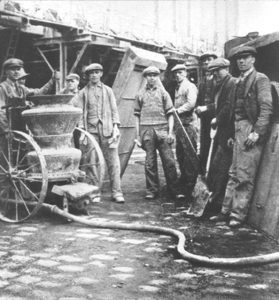
Shotcrete is simply a placement method for concrete. Early shotcrete equipment conveyed dry concrete materials via air through a flexible delivery hose and added water at the exit nozzle, in effect making low water/cement ratio (w/cm) concrete immediately before placement. This was a method that allowed remote placement of relatively high strength, low w/cm concrete mixtures.
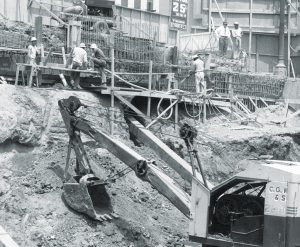
As the materials were shot from a dry-mix gun, the Cement Gun company, which controlled the use of shotcrete equipment in the early days, adopted the tradename “Gunite.” Many still use the old tradename when referring to what we now call dry-mix shotcrete.
The American Concrete Institute (ACI) wrote a standard, Recommended Practice for the Application of Mortar by Pneumatic Pressure (ACI 805-51), and suggested the term shotcrete. After adopting the term, the introduction of high-velocity placement of ready-mixed concrete using concrete pumps and high-velocity airflow pushed ACI to refine the terminology to dry-mix shotcrete (the original gunite) and wet-mix shotcrete for the pumped concrete accelerated by air at the nozzle. This is the terminology in use today.
Benefits of Shotcrete
So, what differentiates shotcrete placement from conventional form-and-pour construction?
- High-velocity placement
- Minimal formwork
- Excellent bond to existing concrete substrates
- Ability to more easily provide curved and tapered sections
- All placement immediately visible
High Velocity
The key to quality shotcrete is high-velocity acceleration and then impact of the concrete. High-velocity shotcrete equipment projects concrete from the nozzle at 60 to 80 miles/hour. The concrete then impacts the substrate (form or previously shot concrete) and is fully compacted and consolidated without the need for external vibration. This allows shotcrete to be placed vertically or overhead against a receiving surface.
Minimal Formwork
In new construction, a one-sided form may be used to define the back surface of the shotcreted section. In soil-supported and underground work, no form is required. In repair, often no formwork is required. Also, since shotcrete does not impose fluid concrete pressure against the form, a much lighter form can be used. This allows constructing curved shapes much more efficiently and at a lower cost. As formwork may approach 40% of a construction project cost, this provides both time and cost savings and sustainability benefits.
Excellent Bond
Whether using shotcrete to repair existing concrete, shooting in multiple layers to build out thicker structural sections, or shooting against construction joints, shotcrete inherently provides an excellent bond. With proper surface preparation, shotcrete can easily provide over 150 pounds per square inch (psi) tensile bond strength. This equates to a bond shear strength of 300 to 400 psi and allows the shotcrete to act monolithically with the concrete substrate. Thus, shotcrete placed in layers acts monolithically. There is no need for a bonding agent due to the high-velocity impact and inherent paste-rich environment at the bonding interface.
Easily Create Curved or Tapered Sections
Since shotcrete does not need to carry the fluid pressure of concrete along the full length of a wall, much thinner and lighter forms are used. Also, a one-side form is all that is required to define the back surface application crews are shooting against. This reduced formwork makes it much easier to create curved sections. Also, since the wall is built-out from one side, it is easy to produce tapered wall sections that make the most efficient use of the concrete.
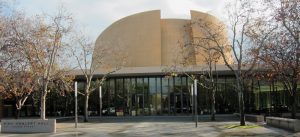
Placement is Fully Visible
Since shotcrete is placed against a form or existing substrate, every cubic foot is visible during placement. An experienced nozzleman, inspector, superintendent, or project manager can continuously know whether the concrete being placed meets the compaction and encasement of reinforcement needed for structural concrete sections. Any problems experienced during placement (slugs of material, tears, sloughs) can be cut out and reshot immediately. There is no waiting until the forms are stripped days later to discover rock pockets or other issues that may occur inside double-sided form-and-pour work.
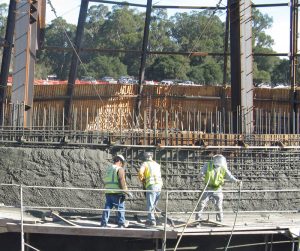
Advances in Shotcrete
Though shotcrete has been used for over a century, the industry has progressed substantially in concrete materials, shotcrete equipment, and placement techniques. In either dry-mix or wet-mix, today’s shotcrete materials are some of the most sophisticated concretes used in the concrete industry. Shotcrete often includes supplemental cementitious materials (SCM), like silica fume, fly ash, slag, or metakaolin. The shotcrete industry was one of the first significant users of silica fume as it increased the adhesion and cohesion of the concrete, allowing crews to shoot thicker layers with a better bond and less waste. Using fly ash has allowed pumping low-slump concrete through smaller delivery pipes and hoses more easily. Alternative cements are also able to be used efficiently and effectively with shotcrete placement.
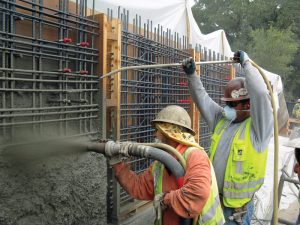
Shotcrete concrete mixtures use common concrete admixtures like high-range water-reducers, air-entraining, summer-time retarders, winter set accelerators, shrinkage-reducers, and corrosion inhibitors. Additionally, the shotcrete placement process provides the unique ability to use rapid-set accelerators, added just as the concrete leaves the nozzle, with the concrete set in a few minutes and providing early strength gain. These admixtures assist applications that are time-sensitive and need to provide structural stability quickly. Many shotcrete contractors have benefited from using hydration control admixtures to extend the time concrete stays fresh for placement. Shotcrete mixtures have also used nano-particle technologies to enhance the fluid flow during pumping yet allow stability when impacting in place. Additionally, fibers, both steel and synthetic, are routinely used in shotcrete. These increase resistance to plastic shrinkage cracking, toughness, and ductility.
Equipment
The original dry-mix equipment proved durable and allowed effective placement. However, dry-mix guns have evolved from sizeable dual-pressure chamber guns to smaller rotary guns. The rotary guns are easier to operate and have made dry-mix very portable. The smaller size lets contractors place their gun, air compressor, and hoses on a single truck. This allows them to roll up on a site and be productive almost immediately.
With the advent of reliable dual-cylinder hydraulic concrete pumps, the shotcrete industry moved to the wet-mix process. This predominately uses ready-mixed concrete delivery and provides increased production rates when compared to dry-mix. Over the years, concrete pump manufacturers serving the shotcrete industry have refined the design to increase pumping pressures, making pumping low-slump concrete mixes through small diameter delivery lines more reliable.
Nozzle designs have evolved as well. Enhanced dry-mix nozzles and pre-dampening systems are available that can decrease dust and waste. Nozzles come in various shapes and sizes to accommodate hand nozzling or remote nozzle manipulation with robotic equipment.
Lidar and laser scanning systems are available to evaluate shotcrete placement. It is expected that systems will provide real-time feedback to the nozzleman on thicknesses during placement in the near future.
Placement Techniques
In the 1950s, ACI began developing standards on shotcrete. In the early years of shotcreting, quality concrete placement was possible, although it depended on the expertise and commitment of the contractor for the work. As the ACI standard evolved, they emphasized the specific techniques required to get maximum concrete compaction with high-velocity impact and full encasement of embedded reinforcement.
Twenty years ago, both the American Shotcrete Association (ASA) and ACI worked together to develop the ACI Shotcrete Nozzle Certification program. ASA developed an education program to support the certification efforts. Simultaneously, ACI has a shotcrete certification committee that maintains the policies and procedures to provide consistency, relevance, and quality of the certification process.
In 2019, ACI added a Shotcrete Inspector certification. This certification is for inspectors who have both concrete and shotcrete experience. ASA provides an education program for inspectors who may be very well versed in concrete and introduces them to the specifics of inspecting shotcrete. Though shotcrete is just a placement method for concrete, there are many details for materials, equipment, and technique that need to be done correctly for quality shotcrete.
ACI Technical Documents on Shotcrete
ACI Committee 506 is ACI’s shotcrete committee. They developed and now maintain many documents, including ACI 506R Guide to Shotcrete; ACI 506.2 Specification for Shotcrete; ACI 506.4R Guide for the Evaluation of Shotcrete; ACI 506.5R Guide for Specifying Underground Shotcrete; and ACI 506.6T Core Quality Evaluation. Several new ACI 506 documents are on the near horizon, including a Guide for the Construction of Pools Using Shotcrete, a Guide to Qualification for Specific Projects, and a TechNote on Shotcrete Preconstruction Mock-ups.
The ACI 506R Guide to Shotcrete is non-mandatory language document that is an excellent primer of all aspects of shotcrete. The ACI 506.2 Specification provides terse, mandatory language that is readily able to be used in a project specification or adopted by reference. The fiber document (see below) gives specifics for using fibers in shotcrete and helps both the engineer and contractor. The Guide for Specifying Underground Shotcrete is a unique document in ACI. It is not a mandatory language specification but a guide for creating a project specification. It provides extensive commentary and example language that helps write an appropriate project-specific specification for an underground job. The Core Quality Evaluation TechNote is useful for engineers to evaluate a shotcrete nozzleman’s performance by evaluating cores taken from a mockup panel.
Several other ACI documents include some aspects of shotcrete or refer to the ACI 506.2 document, including:
Codes and Specifications
ACI 318-19, Building Code Requirements for Structural Concrete and Commentary
ACI 301-20, Specifications for Concrete Construction
ACI 350-06, Code Requirements for Environmental Engineering Concrete Structures
ACI 350.5-12, Specifications for Environmental Concrete Structures
ACI 563-18, Specifications for Repair of Concrete in Buildings
ACI 376 11, Code Requirements for Design & Construction of Concrete Structures for Containment of Refrigerated Liquefied Gases & Commentary
Guides
CCS-4(20), Shotcrete for the Craftsman
372R-13, Guide to Design and Construction of Circular Wire-and-Strand-Wrapped Prestressed Concrete Structures
ACI 506.1-08 Guide to Fiber-Reinforced Shotcrete
544.4R-18, Guide to Design with Fiber-Reinforced Concrete
334.3R-05, Construction of Concrete Shells Using Inflated Forms (Reapproved 2020)
Addition of Shotcrete Provisions to ACI 318-19
Of particular interest to many practicing engineers is the addition of shotcrete requirements into the ACI 318 Code. You can find a past article from ASA’s Shotcrete magazine that provides much more detailed coverage of the changes at https://bit.ly/381CpJg. This was a reprint of an article from the December 2019 Concrete International magazine from ACI.
ACI 318-19 made extensive additions to directly include shotcrete in the Code. As a result of ACI 318’s thorough inclusion of shotcrete, future versions of the International Building Code will remove their specific shotcrete requirements and instead refer to ACI 318 for shotcrete provisions. This will provide more consistency on the requirements for the use of shotcrete placement in structural concrete.
Summary
Shotcrete is well over 100 years old. Through constant improvement in concrete materials, equipment, and placement techniques, the quality of the concrete placed is equal or superior to conventional cast-in-place concrete in strength, low permeability, and durability. Shotcrete offers the engineer and architect a creative and efficient way to use concrete in a wide variety of structures. Indeed, some applications are uniquely suited to shotcrete placement and offer the best, or sometimes the only way to place quality concrete cost-effectively and efficiently. Many codes, specifications, guides, and reports from standards-developing organizations recognize the successful performance of shotcrete placement and including shotcrete provisions in their documents. As a result, designers should feel comfortable including shotcrete in their projects in North America and other countries worldwide.■
